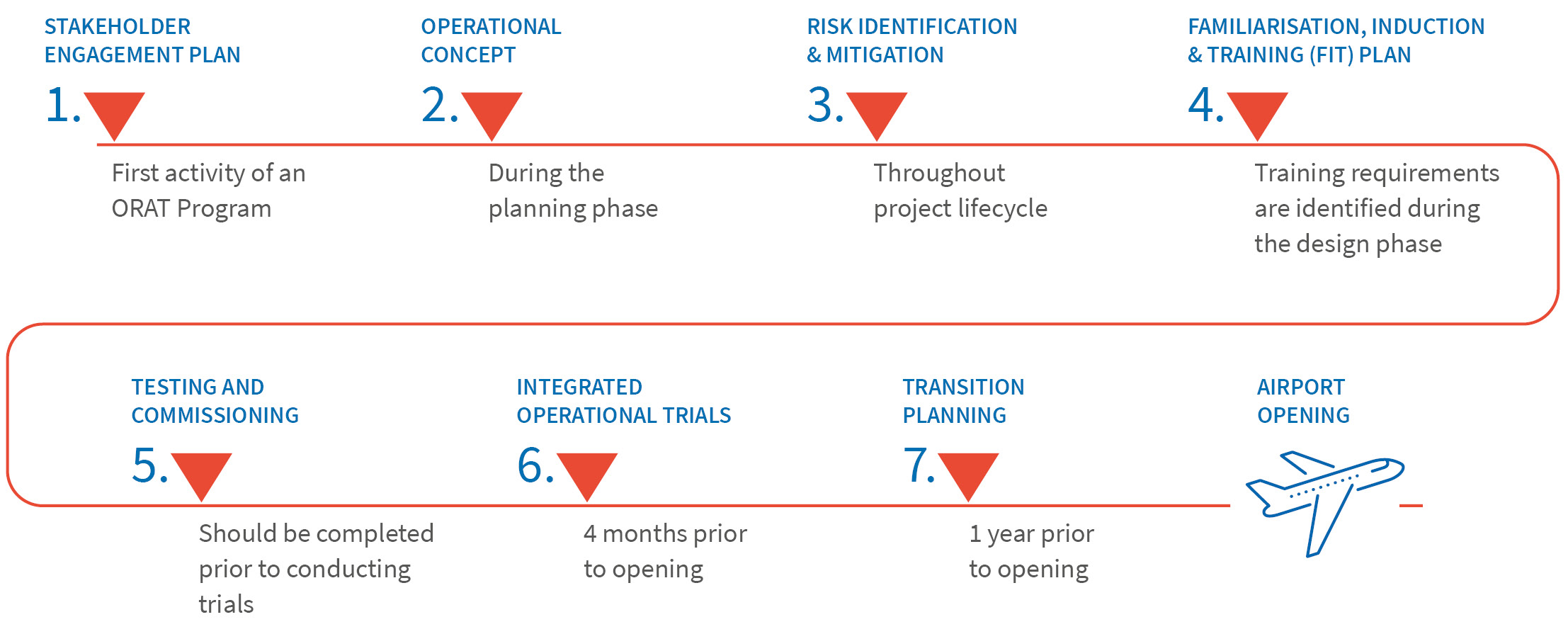How to achieve a smooth Operational Readiness and Airport Transfer (ORAT) Process - 7 Key Steps
-
November 03, 2021
DownloadsDownload Article
-
ORAT, which stands for Operational Readiness and Airport Transfer, is the process of taking a newly constructed airport or part of an airport and turning it into an operational facility1. This complex process should involve all the stakeholders from an early stage so that the new airport facility functions perfectly from day one 2.
The ORAT process encompasses every possible mechanism in the operation of an airport, ranging from the design and maintenance of infrastructure to the lease management of duty-free shops, training of airlines staff and management of parking spaces3. Due to the complex interface, early engagement of stakeholders – as early as the design stage – is the key to a smooth ORAT process4.
When To Do ORAT?
Although ORAT can be deployed at various phases depending on the specificities of each project, the true cost and time savings occur in the early stages of the project.
Ideally, ORAT should be initiated during the design stage prior to construction to influence and address lifecycle costs of systems and equipment. This is achieved through stakeholder engagement during the design phase so that the operational concepts can be captured during project planning. This avoids change orders and design modifications down the road, resulting in significant time and cost savings5.
In fact, it is estimated that 75% of equipment costs are generated during the operation phase versus 25% of the cost during procurement. Hence, the early implementation of an ORAT plan enables the consideration of lifecycle costs before procurement of the systems, resulting in long-term savings6.
Should I Hire an ORAT Consultant?
Although the participation of an ORAT consultant is not required, most airports choose to hire a specialist to deliver this program which is not a steady-state activity for an airport7.
Operations managers may participate in one airport or terminal opening during their career, while construction teams may have limited knowledge of operations. An ORAT consultant can act as a neutral third party, bridging the gap between construction and operations, hence ensuring a smooth ORAT process8.
As Alexander Larisch (Project Director at Fraport) puts it, “Under no circumstances does construction readiness mean operational readiness... When a contractor says construction is finished, you have to add between three months to a year, or even longer, in order to reach operational readiness9.
Moreover, airports are high-security infrastructures that use state of the art technology including automated baggage conveyors, Flight Information Display Systems, Access Control Doors, and complex fire safety systems. Alexander Larisch uses this analogy: “It’s like switching from driving a little Fiat to a Ferrari. These systems are extremely sensitive to rough treatment”10.
Another consideration is the training and familiarization of airport staff, as well as distribution or relocation (for airport extensions) of the airlines. All in all, the ORAT process involves a wide range of stakeholders and requires a thorough knowledge of airport operations. Although it is possible for an airport to perform the process without the help of an external specialist, hiring one ensures a smoother transition and will almost definitely offset the additional cost and time if things go wrong11.
How to perform the ORAT implementation plan
The ORAT implementation plan acts as a roadmap for how the process will be implemented for a specific project. When properly planned and applied, it enables the time and cost benefits mentioned above. Although it should be tailored to each project, the typical scope of work for an ORAT program spans from the design to operation stage and includes the following activities12:
- Stakeholder engagement should be the first activity of an ORAT program. Its intent is to create positive relationships between stakeholders and manage their expectations and objectives.
- Concept of operations is developed during the planning phase. It defines the function of new facilities and captures stakeholders’ requirements to perform their operations. The concept of operations phase is an opportunity to set out KPI’s (key performance indicators) for the operations.
- Project-specific issues, risks, and corresponding mitigation strategies are identified, recorded and addressed throughout the life of the project. This should involve all stakeholders and is usually carried out in the form of stakeholder working groups.
- One of the goals of ORAT is to ensure that all stakeholders are “fit” to operate in the new facility. The “FIT Plan” enables stakeholders to meet their contractual standards for training and to cascade down the required training to staff members. This plan includes familiarisation with operations and maintenance manuals.
- Testing and commissioning - the ORAT team must ensure stakeholder engagement and proper training.
- The integrated operational trials act as a “dress rehearsal” for the opening day. Its purpose is to ensure that facilities, systems, and equipment are operationally ready, and that staff are trained and capable to operate in the new facility. This is also an opportunity to identify areas of improvement before opening. As a general recommendation, the integrated operational trial should be performed at least four months prior to opening.
- The transition plan should start one year prior to opening and be carried out up until post opening. It aims to plan for occupancy of the new facilities and minimise transition risks. It consists of migration plans for all the stakeholders operating in the new airport facility and should be started as early as possible as there are numerous logistical activities that need to occur.
In conclusion, by following the seven steps listed above and involving stakeholders from an early stage, a successful ORAT process can be achieved. When performed properly, it results in significant time and cost savings and helps to avoid disputes down the line, so it’s advisable to act early.
Footnotes:
4: https://www.aviationpros.com/airports/article/12431313/operational-readiness-begins-with-orat
5: https://www.archify.com/au/jacobs-group/updates/detail/reach-new-heights-on-your-knowledge-of-orat
6: https://www.archify.com/au/jacobs-group/updates/detail/reach-new-heights-on-your-knowledge-of-orat
Published
November 03, 2021



